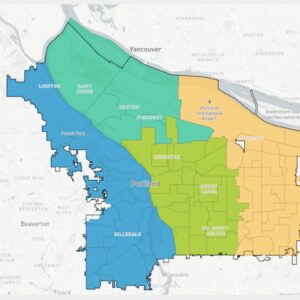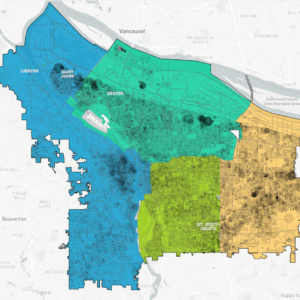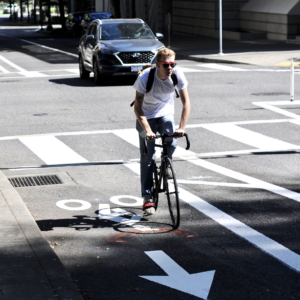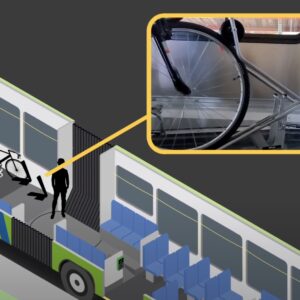
MTB Summit presentation.]
Photo R. Louton
Portland United Mountain Pedalers (PUMP) board member Roger Louton sees a golden opportunity to push for more singletrack mountain biking trails in Portland.
He just returned home from the IMBA World Mountain Bike Conference where he heard the Executive Director of the League of American Bicyclists Andy Clarke, announce some exciting news: the availability of singletrack mountain bike trails is now a key criteria to achieve Platinum status.
Here’s more from Roger Louton:
“This new Platinum criteria is excellent news. We can now hold the city and parks department accountable for the lack of singletrack trails in Portland.”
While this is exciting news for mountain bike advocates like Roger, it’s bad news for Portland’s Platinum quest. Why? Because Portland currently has only 6 total miles of singletrack.
In fact, while Portland touts its 267 miles of total bikeways, according to Louton there are only 35 miles in the entire Portland metro area where someone can legally ride a bicycle on a natural surface.
Louton senses the time is right for increased activism around this issue. At the recent Portland Bike Summit, he pulled Transportation Commissioner Sam Adams aside and illustrated his message (see photo at right).
Louton’s message is that the lack of trail opportunities in Portland means mountain bikers must drive to their favorite trails. This wastes gas, adds to congestion, and presents a loss of potential cash to the local economy.
To show them what mountain biking (on non-gravel roads) is all about, Louton has invited Adams and Parks Commissioner Dan Saltzman to join him on a singletrack ride in Scappoose (20 miles outside Portland).
This will be an interesting issue to follow because not everyone is gung-ho for increased mountain bike access in Forest Park. I have a few meetings set up to hear other perspectives on the issue and I look forward to presenting both sides.
If you want to find out more about the status of singletrack in Portland or learn how you can help Portland become more mountain-bike friendly, join PUMP at their monthly meeting at 7:30 tomorrow night at the Lucky Lab Brewpub (915 SE Hawthorne).







Thanks for reading.
BikePortland has served this community with independent community journalism since 2005. We rely on subscriptions from readers like you to survive. Your financial support is vital in keeping this valuable resource alive and well.
Please subscribe today to strengthen and expand our work.
Having to use gas to ride seems so counter-productive to the biking culture, but I MUST have some twisty-turny singletrack that doesn’t involve sharing the equivilant of i-5 with cranky joggers and walkers.
This is good news! Yea!
The lack of singletrack drove me away from Portland. The everyday biking brought me back. It’s good to hear that the presence of singletrack is seen as part of the whole.
Man it’s freakin hot out!
T!
This is great news! I love the bike culture of Portland, but I sure do miss being able to ride my bike to singletrack trails. Driving is such a waste.
Great news! The current state of mountain bike trails in Portland is absurd, I’m glad to see there’s starting to be some incentive for the city to allow us some singletrack.
Always thought it was weird that Portland has the 3rd largest largest city park in the nation, yet has so few trail miles dedicated to mountain bikes.
Chico, scene of my so-called college education, offers MUCH more singletrack in Bidwell Park (the nation’s 4th largest city park btw). Their system to manage, maintain and protect the trail network could serve as a model for Portland’s efforts.
Did Davis, CA’s Platinum designation have anything to do with single-track mileage?
I would hope the city of Portland focuses first on improving the overall bike network that benefit the largest number of cyclists (including the south waterfront path, the Rose Quarter mess, closing gaps in existing routes, etc) before putting resources into Forest Park trails that will only benefit a smaller subset of cyclists.
Stephen said,
Most likely it did not because this is a new criteria.
And as for the city focusing efforts on the bike network… they’ve been doing that for over a decade now.
Maybe it’s time to share the love and work on some non-paved options?
And I think you should be careful when making assertions that “Forest Park trails will only benefit a smaller subset of cyclists”. There are more MTB’ers in this town than you realize.
Also, I think as a bike community we need to support all forms of riding and not discriminate against our knobby-tired bretheren.
Let’s work together to strengthen the bike network…both on and off road.
It is a great pollution free recreation. I miss the single track in michigan ! Consider making the trails One-Way for safety and it also makes a lot more fun cause you can go fast and not have too worry about doing a head-on.
I think the trails could be created and maintained by volunteers, just need approval from portland parks?
A lot of people already use forest park to commutte home to the west side. It’s pleasant, quiet and nice. Some great trails could increase this usage. Also once you get people on bikes, no matter what sort of cycling, you have created people that most likely will start biycle commuting too.
Does Amsterdam’s lack of good singletrack make it less friendly to bicyclists?
This is bad news. I’m a mountainbiker, but I’m also interested in sustainable transportation and development. I’m very disappointed with this new criteria. A well-planned, dense, mixed-use community should be able to be recognized for their efforts to make bicycling safe and accessible. This criteria muddies that goal.
I’m fine with giving cities credit for access to mountainbiking, but to require it for top status is dangerously misguided and lacking foresight. What, for instance, does NYC have to shoot for? With this criteria, a city could be as bike-friendly as Copenhagen but still denied Platinum status.
I’d encourage LAB members to write a letter to Clarke and tell him that, although we appreciate the sentiment, this new criteria is a bad idea.
Carl,
I understand your concerns…but I think we might be overestimating this new criteria.
I’d like to hear straight from Andy Clarke, but my hunch is that this is just one (of many) criteria and that mountain bike singletrack trails are in now way a requirement to becoming Platinum.
My feeling is that if a city has the potential to offer mountain bike trails, they should be somewhat obligated to provide access to them when and where it’s appropriate.
Also, let’s not forget the LAB’s place in all this. They are not a 100% objective bike-friendly watchdog. They do great work and they are having a huge impact on the bike-friendliness of our country…however,
They are also a business that needs membership dues to survive and perhaps they realize the potential in engaging the mountain bike community with this new criteria. It will certainly get them some good PR and exposure with the hundreds of thousands of mountain bikers (and potential LAB members) around in the country.
Phew! I sure hope we’re overestimating.
I was just going by what I read:
“The availability of singletrack mountain bike trails is now a key criteria to achieve Platinum status.”
If you receive clarification, I’d be interested to hear.
Meanwhile, let’s not get too hung up on what precious metal the LAB associates with us. We know we’ve come a long way and have a long way to go. LAB’s “Platinum” is only relative to other U.S. cities (which isn’t a very high bar) whereas Portland should be aiming far higher than that. I’d hate to see Portland branded “Platinum” and assume that there’s nothing left to do.
I recognize that this discussion would be perhaps better hashed out under another, more general, post…
I share Carl’s and Stephen’s concerns. I think the priority should be ensuring the regional network of trails that is used by literally thousands of cyclists—mountain bike and other cyclists—-and by runners, walkers, nature viewers, people with strollers, and walkers/wheelchair bound folks.
Portland Parks and Recreation and Metro has an amazing interconnected regional trail plan that you all should be aware of and support. Ultimately, it is that interconnected system of local and regional trails that will increase cycling of all types in Portland and throughout the Portland-Vancouver region.
I am not dismissing the validity of the desire of some cyclists for more single track mountain bike trails, but in my opinion that system would, indeed, be used by a very small segment of the population, including the cycling community for that matter.
If the desire is a single track system of trails I believe that will require a holistic planning effort, not just “grafing” a system onto the existing network of nature-based trails and walking paths. Based on my twenty-six years of leading nature cycling and walking tours, I have great concerns—both in terms of safety and ecological impacts— about using existing trails in Forest Park and other nature parks for single track mountain biking.
Thanks for running this blog. I have found the exchanges to be thoughtful and helpful in informing me what the single track mountain bike advocates are thinking about the issue. I look foward to reading future dialogues on the issue.
Mike Houck
Mike,
I think the problem right now is that decision makers and natural areas experts are looking at existing trails when they consider mountain bike use.
This creates a misperception that mountain bikes cause a lot of trail damage because the existing trails are not built for mountain bike use.
If you observed singletrack that was built by professional, IMBA certified trail builders you would see that mountain bikes cause no more damage to natural areas than hikers, horses or runners.
Therefore, we must reserve judgement of the impact of mountain bikes on the trails until mountain-bike specific singletrack trails are constructed.
Jonathan,
We are on exactly the same page. My problem with some mountain bikers is that their argument has been to, as I said in my earlier posting, “graft” a single track (although the single track jargon has just come into useage) mountain biking trails onto the existing sytem.
That approach is doomed to failure, both for mountain bikers and other trail users, in my opinion. I have had groups of bird watchers literally mowed down by out of control mountain bikers on Powell Butte and Oaks Bottom Wildlife Refuge. Most existing trails are unacceptable for both “high thrill” mountain bike use and birding, strolling, hiking.
In my opinion, if single track mountain bike advocates really want a good system, we have to start from scratch and do it right. We also need to involvd a broad bicycling-hiking-walking-nature viewing constituency to do that work. Whether such a system could actually be constructed inside the UGB is an open question in my mind, but one that needs to be explored in a holistic manner, not an ad hoc piecemeal approach. I’m open to that effort.
So, if I read your response correctly, I think we agree.
Mike
Jonathan,
Great posts, your site is a work of art!
Meanwhile:
No scientific studies show that mountain bikers cause more wear to trails than other users.
A summary of scientific studies that compare mountain biking to other forms of trail travel can be found here:
http://www.imba.com/resources/science/impact_summary.html
Mountain biking, like other recreation activities, does impact the environment. On this point, there is little argument. A body of empirical, scientific studies now indicates that mountain biking is no more damaging than other forms of recreation, including hiking. Thus, land managers who prohibit bicycle use (while allowing hiking or equestrian use) based on impacts to trails, soils, wildlife, or vegetation are acting without sound,
scientific backing. All we ask is that fact based decisions be made as to where mountain bicyclists can share the trails with other trail users. Don’t forget, we pay taxes too, with those tax $’s funding the Parks Dept. budget. We also buy 37% of the bicycles in town, from over 55 local bike shops. Is that a ‘minority subset’ of cyclists?
My bike is comprised of parts made here in Portland, along with parts made in Canada, a NAFTA trading partner, and costs over $4000. Is that a minor purchase? Certainly not. Think of how many others spend that much, helping the local economy. It’s just too bad we have to dump $3 a gallon ino our cars to ride our bikes. That is money that could be better spent at local shops, stores, etc., filling their cash registers, not those of big oil companies. Note the picture above of the ‘Favorite Trails’. Had us mountain bikers decided to not attend the bike summit that day, and went riding at just those 7 different places, we would have driven a total of 375 miles, ONE WAY, to those trails. All the while contributing to global warming, etcetc. Is what Portland wants to be known as, a great bicycling city, EXCEPT if you enjoy riding your bicyle amongst the trees away from vehicular traffic?
Mountain bikers have emerged as leaders in volunteer stewardship of our public lands. Each year, IMBA members and the members of 500 IMBA-affiliated groups perform nearly one million hours of volunteer trailwork to improve
shared-use trails and protect natural areas.
IMBA is a worldwide leader in developing and teaching innovative trailbuilding techniques that help make shared-use trails more
environmentally sustainable. Trail access for cyclists is almost universally better now across the USA than it was 10 years ago, and this is directly related to solid relations between mountain bikers and land managers. We hope to improve trail access here in Portland.
Local Government officials are now looking to mountain bikers for solutions to improving access to trails, while balancing increased population pressures and environmental concerns. We are excited to be involved and look forward to working with all cyclists, land managers and gov’t officials as we move forward with the ‘Platinum’ project.
IMBA and PUMP seeks to continue to build upon that foundation by keeping an open and positive dialogue going into the future.
Lets keep talking. We want to raise awareness of this challenging issue.
Roger W. Louton
http://www.IMBA.com
Western OR Rep
http://www.PUMPCLUB.org
Mr. Houck,
You stated : “the single track jargon has just come into useage”.
That is hardly the case. Please read on…..
It may state it was ‘invented’ in 1997, but the term has been in use since the 80’s.
DEFINITION OF SINGLETRACK
Today, the term “hiking trail” is an improper synonym for singletrack. It defines a type of user, not the physical structure of the trail.
The Sierra Club in 1997 invented a better definition:
“A single-track trail is one where users must generally travel in single file.” (The hyphenated form of the word is obsolete.)
The trailbed of singletrack trails is typically 12 to 18 inches wide. Singletrack trails tend to wind around obstacles such as trees, large rocks and bushes. Compared to roads, singletrack blends into the surrounding environment, disturbs much less ground, and is easier to maintain. The tread of singletrack is almost always natural surface, in contrast to the gravel or pavement of roads.
THE SINGLETRACK EXPERIENCE
All experienced trail users prefer narrower trails. For cyclists, it’s a favorite experience. Most other trail users similarly value this limited resource, and when they compete for it, conflict sometimes arises. Making peace on the trails requires that all trail users and land managers understand the importance and meaning of singletrack.
Land managers and trails activists need to know that mountain bikers desire singletrack for very similar reasons as hikers.
Every cyclist who progresses beyond a beginner level eventually seeks to ride on trails. Why?
Most trail users want to experience a close connection to Nature. Singletracks provide this better than roads. Trees and shrubs may envelope you in a tunnel of green. Tall flowers may reach eye level and higher. The experience just isn’t the same when you are walking or pedaling on an open, wide road. When
you are pedaling slowly on singletrack, you feel the wind, you smell the flowers, and you feel connected to the natural world.
Singletracks separate recreationists from the world of the automobile. Cars cannot use singletracks. Even jeeps are too wide. In
some places singletracks run parallel to adjacent roads, and nonmotorized recreationists will often prefer to travel the narrow trail, even though it is slower and more difficult.More often, singletracks run far from roads, providing the transportation systems of backcountry areas.
The mountain biker’s desire to ride and protect singletrack correlates with the hiker’s desire to walk through wild or roadless areas. The higher degree of challenge inherent to singletrack appeals to many trail users.
Roger W. Louton
http://www.IMBA.com
Western OR Rep
http://www.PUMPCLUB.org
Trek had a bike called a Singletrack in the 80’s. Back when I rode mountain bikes, before front suspension, I prefered to ride singletrack. This is like 1987. So, hardly a new term.
It bums me out that I can bomb Washington Park on the street, but if I wanted to do the same thing off-road, I would be breaking the law. But that’s not my main concern, I don’t think it’s fair for the hikers I would be scaring the shit out of. Washington Park NEEDS mountain biking trails. Every time I ride the MAX past Washington Park/ Goose Hollow there are groups of young kids with *extreme* looking freeride bikes, covered with dirt and wearing helmets. Unfortunately, because there are no bike trails, there are all outlaws.
In a lot of ways I think the single track biking question is related to Portland’s focus on building infrastructure supporting activities for 45+ year old residents who don’t have children at the home (this pretty much describes my wife and I by the way).
What I see when I hike, bike, and canoe around town, are parks and greenspaces that have been kid-proofed.
For example, right off the paved bike/run/walk path that runs from OMSI to the Sellwood bridge, there is a short section of single track between the river and the paved path. It used to have a series of small jumps clearly build by kids to ride on. About a year ago, a bunch of the city’s ubiquitous “no bike” signs showed up and another unstructured outside activity for kids was put off limits. Now it looks like the trail is suposed to be used by nature walkers only.
I know when I was a kid, I did not spend a lot of time on nature walks. My friends and I would go out to the nearest forest or undeveloped areas and run around throwing rocks at each other or buidling jumps for our bikes.
Today we are driving our young people indoors to play video games. We don’t leave them any outdoor activities that they want to do.
We have build a city that is great for bike commuters, bird watchers, and nature walkers. Just count the number of “no bike” and “no skateboard” signs in the city limits.
My wife and I enjoy doing nature walks on West Hills and Forest Park trails, watching birds and commute to work by bike, but I would also very much support the addition of some single track trails for bikes within the city limits. It would be a good and fair balance in my opinion.
Roger Louton,
Sorry, yes I had assumed the term has been in use among cyclsts for some time, but is very recent in my experience in the Portland area in the context of this dialogue.
However, the terminology was not really my point. Yes, some singel track riders’ motivation may be “experiencing” nature, but frankly, as one who has led nature hikes, kyaking trips and cycling trips for three decades in the Portland metro area those off-road mountain bikers I have observed (by the way I own two mtn bikes and two road bikes myself) are in it primarily for the work out and the thrills. I have never seen an off-road mountain biker with a pair of binoculars, a plant guide, or any other evidence of their being on a natural history outing. Nor is the speed I routinely see them screaming down the trail indicative of their communing with nature.
The irony in your observation that they are motivated by the same experience hikers are seeking is that on many occasions on my nature walks the group I was with was literally forced to bail off a trail by a group of mountain bikers barreling down on us on a narrow hiking trail. This was particularly true on the Powell Butte trails which are especially steep.
That’s why, in my opinion simply opening up existing narrow hiking paths is not a viable option to meeting the needs of either singletrack mountain bikers or those who are out on the trails leading a nature hike, on a quite solo walk, or simply out for a contemplative stroll.
Mike Houck
I haven’t been involved in the discussions, so I don’t know if this has come up, but there are a number of places that have solved the issues between hikers and MTBers by regulating days. MTBers get odd days/ hikers get even days in mixed use trails. Utah does this and seems to work well.
A Park in So Cal where I used to ride, had one main ‘one way’ up trail(more like fireroad) and one ‘one way’ main down with many intersecting trails. This allowed hikers and inexperienced riders a level of safety, while still providing more “real” singletrack.
Those who are in it for the *thrill* usually have 6 inches of travel at both ends and would prefer a fire road to bomb at 50mph plus. I don’t have field gide but I definitely enjoy poking along at about 5-10 mph hopping over tree roots and threading my handlebars thru trees and branches. I like the *technical* aspect of singletrack riding.